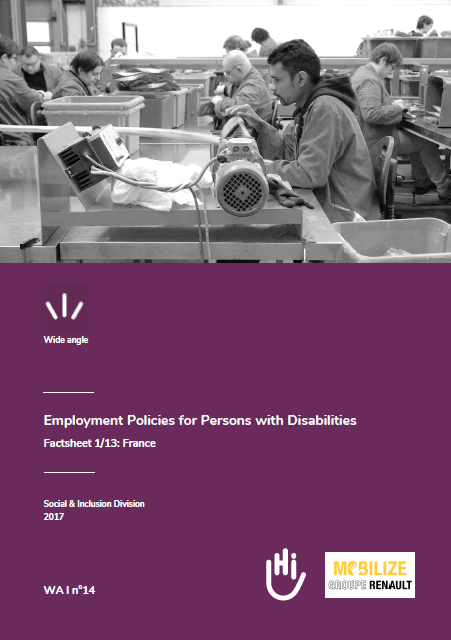Inclusive Employer Toolbox




15% of the world population lives with a disability. According to ILO, over 80% of people with disabilities are excluded from the labour market, which entails a global GDP loss of US$ 2 trillion a year.
You wish to hire more staff with disabilities and better inlude them in your company? HI offers you free tools based on its field experience to get started on your inclusion journey:
- A series of "Good Practices for Inclusive Employers" factsheets, based on successful experiences from companies around the world;
- An introductory email series to get you started, entitled "Employers, Aim for Inclusion!";
- A series of memo cards summing up our best advice on various aspects of work inclusion;
- Inspiring video testimonies.
Navigate through the five dimensions of an inclusive company to explore this free content!
Taking an holistic approach to successful and sustainable inclusion in companies
The example of Michelin in INDIA




Study: Situation of Wage Employment of People with Disabilities
10 low- and middle-income countries in focus. A qualitative study by HI, including innovative recommendations.




Success Story: Michelin's Inclusion Journey
(COMING SOON) Michelin describes how they piloted a disability inclusion programme at their site in Chennai, India. The document includes useful tips & lessons learned.




This means that all institutional data, company policies and processes should include disability issues and quality monitoring for global commitment and change.
Testimony: Michelin in India
The Director of Michelin's site in Chennai (India) tells us how he championed the "Inclusive Employer" program in the plant, with help from HI and the Michelin Foundation.
GOOD PRACTICE
GOOD PRACTICE
GOOD PRACTICE
Setting up a Committee to Monitor the Inclusion Action Plan
Michelin's experience in INDIA




To ensure inclusive HR & management practices, companies should transform the entire HR cycle from sourcing, recruiting and welcoming, to retaining, career development and retiring. For example, this includes reasonable accommodation, salary equality, equal internal mobility opportunities, etc.
This dimension also involves the review of management practices so that they become more inclusive and respectful of all staff members’ situation and needs.
GOOD PRACTICE
Reviewing the recruitment process with jobseekers with disabilities
The experience of a hotel chain in INDONESIA
GOOD PRACTICE
Adapting job conditions to avoid discrimination
Alfamart’s experience in INDONESIA
GOOD PRACTICE
GOOD PRACTICE
Adapting staff training courses for deaf employees
Michelin’s experience in INDIA
Companies, do you think it is too difficult or too expensive to recruit persons with disabilities? It is not. This one employee’s story tells us how small changes can make all the difference in a
Kiki’s daily work thanks to reasonable accommodation
The story of this employee with hearing impairment tells us how small changes can make all the difference in a job.
MEMO CARD
MEMO CARD
MEMO CARD




Study: Employment Policies for Persons with Disabilities
Comparative study in 13 countries: Legal obligations and recommendations for companies.








Discrimination is one of the biggest barriers faced by people with disabilities when accessing employment. By transforming its corporate culture using information and awareness-raising events, the company will create a more enabling environment for people with disabilities, facilitating recruitment and increasing comfort in the workplace.
This dimension therefore involves improving the level of information on disability, changing staff attitudes and behaviour, setting up accessibility rules for documentary resources, improving communication tools and spaces, etc. All these activities will help reduce the communication bias on disability.
GOOD PRACTICE
Raising awareness of inclusion in your teams with Blind Football
Casanet’s experience in MOROCCO
GOOD PRACTICE
Putting employees in the shoes of people with disabilities for a day
Michelin’s experience in INDIA
MEMO CARD
Stereotypes, cognitive bias and discrimination
HI's recommendations for companies




Accessibility is not just about removing physical barriers with an access ramp to the office. For example, it should also mean checking whether the website is accessible for all jobseekers and employees, whether the font used in documents is easily readable, and whether subtitles appear in videos, etc. After assessing all barriers, the company should consider what adaptations can be made – the solutions are often simpler than you might think!
Full text transcript for the video available at: https://www.citizensonline.org.uk/full-transcript-a11y-video/
Introducing digital accessibility
Discover why digital accessibility is important and how to make technology work for everyone. In employment, it can impact recruiting processes as well as training, internal communication, etc.
Accessibility in the workplace: where do we start?
HI's recommendations for companies
GOOD PRACTICE
Assessing company accessibility using a participatory audit
Michelin’s experience in INDIA
MEMO CARD
Accessibility for buildings open to the public
HI's recommendations for companies
GOOD PRACTICE
Facilitating the mobility of employees with disabilities
Gourmet Collection and Alfamart’s experiences in INDONESIA




Inclusiveness cannot be achieved alone. Many organisations work in the field of disability and can help companies become more inclusive employers. Building partnerships with OPDs (Organisations of Persons with Disabilities) in the area will allow the company to assess the needs of people with disabilities better and find relevant answers. This involves using a participatory approach with representatives of people with disabilities to ensure fair changes.
abc
1234
Egypt: Successful Partnerships for Disability Inclusion
The company’s Director and several employees with disabilities talk about their experience working together after finding one another through the help of specialised organisations.
GOOD PRACTICE
GOOD PRACTICE
Training recruits with disabilities directly in the company
Ouidah Pain’s experience in BENIN
Partnering local organisations for disability inclusion
Michelin’s experience in INDIA




Guide: "Good for Business"
A guide for collaboration between employers and organisations working in the field of disability inclusion, with demonstration that inclusion facilitates companies' growth and productivity.




Global Business Disability Network's Publications
Discover the many resources of the Global Business Disability Network (GBDN), founded by the International Labour Office (ILO).
HI’s expertise on the inclusion of persons with disabilities dates back to 1982. Through our Inclusion Technical Assistance (ITA), we are already supporting other NGOs in improving the inclusion of persons with disabilities, from the initial inclusion assessment to long-term coaching.
Starting from 2022, we will also help companies, international agencies and governments to become more disability inclusive employers. Contact us now to learn more!
Publication funded by











